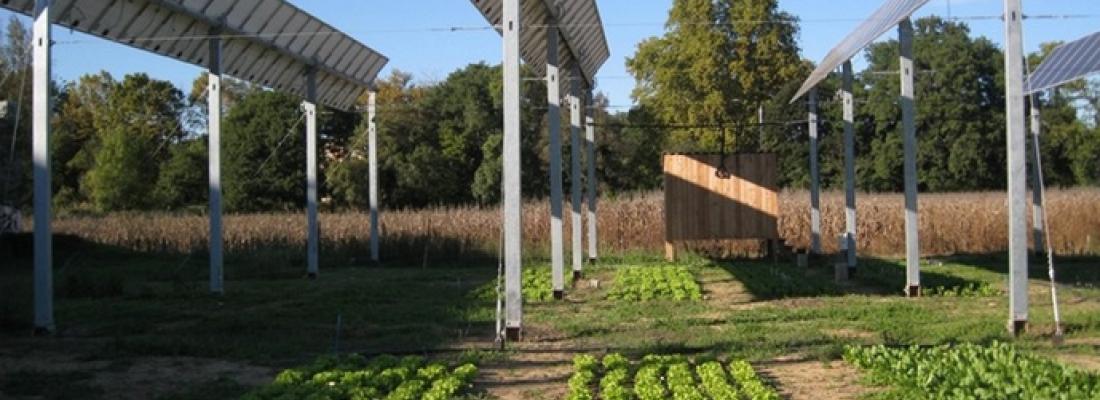Bioeconomy Reading time 4 min
Towards photovoltaic systems that can reconcile the production of crops and electricity
Published on 26 June 2017

Renewable energy is one of the pillars in the fight to control global warming. The photovoltaic market is seeing considerable growth, but the siting of farms is subject to environmental constraints, as it is limited to non-arable areas or those which integrate mixed use.
The Sun’Agri project was initiated in 2009 in response to this challenge regarding land use, in the context of a partnership between INRAE and the company Sun‘R. It aims to develop agrivoltaic systems that can combine agricultural production with that of electricity, simultaneously and on the same plot.
From proof of concept to the design of dynamic agrivoltaic systems
Agrivoltaic systems were inspired by the principle of layered cropping and agriforestry, where several species are cultivated on different levels, thus creating a synergy between them. In the present case, the top layer is made up of photovoltaic panels.
The first stage of the project associating Sun’R and INRAE focused on an experimental evaluation of the feasibility of this system using fixed photovoltaic panels and different crops. These studies demonstrated that it was possible, under certain growing conditions and by altering the spacing of panels, to sustain agricultural yields at levels comparable to those achieved by field crops, despite a reduction in the radiation available to the plants. This work also clarified the limitations of a system providing fixed shade.
Based on these results, a new stage in the project was initiated, and enabled the development of a dynamic agrivoltaic system with mobile panels that could modulate the shade given to the underlying crop.
Design of this system required the definition of innovative technical solutions at different levels, and therefore necessitated the involvement of new partners: Optimum Tracker, Photowatt and CEA for the design of photovoltaic modules, and IRSTEA to deal with water and irrigation aspects.
During this second stage, the INRAE scientists focused on the ecophysiological dimension of the system. Indeed, the management of shade and the definition of appropriate algorithms to control the orientation of panels posed new questions. Most of the detailed knowledge concerning the changes triggered by the shading of plants had been acquired in the context of fixed and continuous shade or under the effects of short-term radiation peaks, such as those observed in undergrowth.
Studies focused on the responses of an annual crop to the microclimatic changes generated by the presence of mobile panels, using an experimental system over three seasons. This made it possible to model the impact of panel orientation on the biomass produced, and to optimise the management of panels as a function of climatic scenarios and yield goals.
A system to be deployed in its pre-industrial phase
After this second stage, the Sun’Agri project is now being extended thanks to funding from the government’s Investments for the Future programme (PIA3). The aim is now to work at a large scale and under real-life conditions on evaluating the feasibility and effects of dynamic photovoltaic systems on different crops with a high added value (arable crops, market gardening, arboriculture, viticulture). Experimental sites and demonstrators will be set up under real-life conditions in order to reach the stage of marketing these agrivoltaic systems, whose maturity is envisaged in 2022.
The three phases of the Sun’Agri project:
Sun’Agri 1 (2009-2013) Study of the behaviour of plants under different configurations of fixed photovoltaic shade and a wide variety of crops.
Industrial partner: Sun’R
Academic partner: INRA
Funding: one CIFRE thesis project
Sun’Agri 2 (2014-2017) Design of dynamic agrivoltaic systems.
Industrial partners: Sun’R, Optimum Tracker, Photowatt (EDF ENR PWT)
Academic partners: INRA, IRSTEA, CEA
Funding: Special Ministerial Fund (including CIFRE thesis projects).
Total budget: €5 million (not incl. tax)
Sun’Agri 3 (2018-2022). Development of dynamic agrivoltaic systems at a commercial scale: development in three representative species, optimisation of the robustness of management protocols, structuring of scientific research around dynamic agrivoltaic systems.
Industrial partners: Sun’R, Photowatt (EDF ENR PW), Sun’R Smart Energy, ITK
Academic partners: INRA, IRSTEA
Funding: Investments for the Future (PIA3), programme of demonstrators for ecological and energy transition.
Total budget: €15 million.
